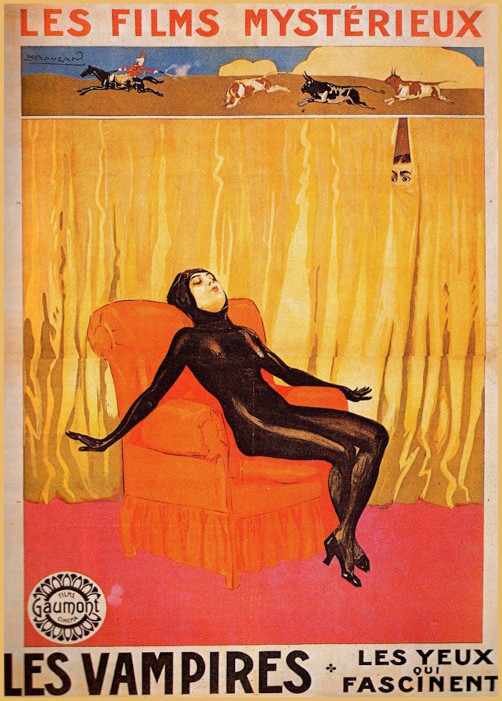Eye For Film >> Movies >> Les Vampires (1915) Film Review
Les Vampires
Reviewed by: Donald Munro

Les Vampires is the second of Louis Feuillade's crime series. The ten episode serial first ran in cinemas between 13 November 1915 and 30 June 1916, whilst France was deeply embroiled in World War 1. Feuillade revisits the world of the Apache gangs. He does it in an even more sensational way than he did in Fantômas, which is saying something.
The serial starts with an introductory episode, La Tête Coupée (The Severed Head). A young and ambitious newspaper reporter, Philippe Guérande (Édouard Mathé), has been investigating a shadowy criminal organisation known as Les Vampires. He is called into his editor's office, where he is informed that an Inspector Durtal, who was also investigating Les Vampires, had disappeared. Then he is shown a telegram, most of Durtal has shown up near Saint Clement Sur Cher. An old friend of Guérande's family has a chateau out there. That would be a good place to stay as he probes the mystery of the missing head. The plot twists and turns through secret passages and trap doors.

That first episode sets the tone for the rest of the series: The brutality of the gang; the use of disguise and deception; the rooftop acrobatics; the way that corruption and criminality extends into the upper echelons of society. It acquaints us with Guérande and many of the recurring supporting cast, such as the everyman Oscar Cloud Mazamette (Marcel Lévesque), who provides much of the comic relief in the series. Lévesque's talent for physical comedy is remarkable. The other important characters turn up later in the serial. Juan-José Moréno (Fernand Herrmann), the leader of a gang that tangles with Les Vampires in episode four, and Satanus (Louis Leubas), the shadowy over-boss of Les Vampires in episode seven.
The most iconic character in the series appears in episode three. As possibly the first fully fledged femme fatale in the history of cinema, Irma Vep (Musidora aka. Jeanne Roques) is iconic. There are vamps before her, the first being Alice Hollister as Sybil in The Vampire[1] (1913). With the sex, intrigue and cigarette smoke swirling around her, she's just waiting for film noir to come around and show its soft vulnerable underbelly. We see her first performing on stage at Le Chat Hurlant. What makes Musidora's performance so engaging is the way she uses her eyes. First the eyes move and then the body. It gives Irma Vep a heightened sense of dynamism and intentionality. Mario Bava uses something of the same in Danger: Diabolik to capture the movement that comic book artists imply between frames. The uniform of Les Vampires is the blacks of a stage hand, invisible as they redress the stage between scenes. They do their work in the dark without you even noticing. Irma Vep's is shiny, black, almost translucent silk. You wont often see its like again until the 1960s. Think Batwoman (Lee Meriwether) in Batman and Emma Peel (Diana Rigg) in The Avengers (A Touch Of Brimstone). In or out of the outfit, Musidora's stunt work is spectacular.
Time has moved on since 1913 and Fantômas, Feuillade's skill as a filmmaker has improved, as has the equipment. Les Vampires is less episodic. Although some of the episodes are self contained, there is a continuous story arc running through the whole series. His indoor sets are still cluttered but outside he makes more use of the openness and of the trappings of modernity: the car, the train, the tram, the movie theatre. He is also a little more experimental in his use of transition and, in one instance, the early use of split screen. He isn't pushing the boundaries of the technology so much as using what he knows will work to get the needed effect. Despite the serial being escapist, aspects of World War One do bleed in. Gas masks, poisoned gas and warships make appearances.
At the time, one complaint that critics had was that he wasn't pushing the boundaries of what film could do. The majority of the criticism was directed at the disreputable content in Les Vampires, however. France's right wing press pilled on over the glorification of crime, the sexual catsuit and general immorality. Now that Les Vampires is considered a classic of silent cinema, there is criticism of Feuillade for his right wing politics.
Feuillade had a strict, conservative, Catholic upbringing, He joined the army and tried to have a career working for the right wing press. As a film maker, on the other hand, he based the gang Les Vampires on the anarchist bandit gang La Bande à Bonnot and essentially glorified their actions. He met Musidora while hanging around cabaret hall Folies Bergère. Her politics were hard left, being part of the anarchist film cooperative Le Cinéma Du Peuple. Their working relationship lasted years. He first gave her leading roles and then mentored her as a writer and director of her own films.
In the second episode, The Ring That Kills, the ballerina Marfa Koutiloff (Stacia Napierkowska) performs Dance Of The Vampire, it was a cabaret act based on the roll played by Alice Hollister. In this version the sex of the victim is changed to a woman. The title of the final episode of Les Vampires, Les Noces Sanglantes (The Bloody Wedding), refers to the 1572 Saint Bartholomew's Day massacre. It seems like a not too subtle hint that what the forces of justice are about to do isn't right. The serial would seem leftist. Maybe Feuillade was just very comfortable giving people what they wanted to see, maybe he shifted to the left, or maybe his politics were always complicated. One thing is certain: World War One upended a lot of people's ideologies, both political and religious.
Despite not being technically innovative, Les Vampires pushes a lot of boundaries and in its day touched some raw nerves. Feuillade made his serial to be popular, to entertain, and not to garner praise from critics. It is one of the most striking and entertaining pieces to have survived from the era of silent film.
[1] based on the Rudyard Kipling poem, which was itself based on the 1897 painting by his cousin Philip Burne-Jones.
Reviewed on: 14 Nov 2024















